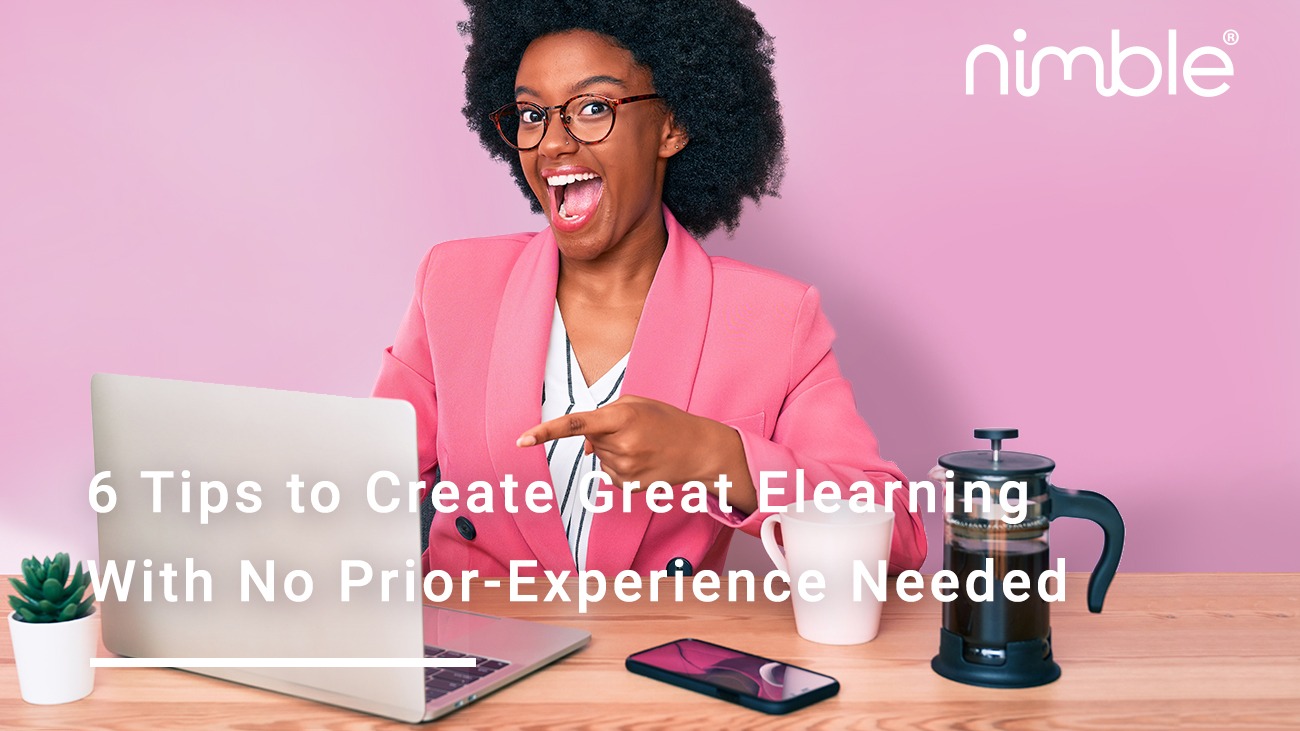Approximately a 5 minute read
Making excellent elearning for the first time is much easier than you might think, especially when you’ve got the right tools to do it simply and easily. That’s why we’ve put together the following list of 6 tips to help you create great elearning with no experience needed.
1. Use an authoring tool with a ‘learner-view’ interface

Even if you’re not someone who is experienced with training or creating elearning content, you might well know that you will need an authoring tool to help you create your elearning course. There are many authoring tools out there, ranging from PowerPoint conversion kits to bespoke tools used by professional elearning content developers (that have all the bells and whistles that only they need).
If you’re just starting out creating elearning, then you likely won’t be familiar with how authoring tools work. Many use a back-end interface, where you create your course using a series of forms in the back-end, before publishing it to see a final course. Others provide a more friendly learner-view, allowing you to design the course as your learners would see it. Sometimes this is also called WISIWIG editing (what what you see is what you get). Back-end based authoring tools can be complicated for people who are just beginning to create courses for the first time.
An authoring tool with a learner-view interface allows you to design all of your courses as your learners will see them, which means you don’t have to keep switching between views to set up a great piece of elearning. Nimble Author is exactly that – it makes it super simple to design elearning that your learners will find easy to understand and follow, and also helps to save you time along the way.
2. Use free images and media

If you’re creating a course from scratch, you might not have a lot of media such as images to put into your course already. There are a number of free options out there that can help you inject the look and feel you want into your course, and help make it more engaging.
Some authoring tools like our own Nimble Author come packaged with a free image library that you can use as much as you want to enhance the learning experience you are creating. If your authoring tool doesn’t have an inbuilt library, there are a number of free stock image sites with a great selection of images that you can use to find media specific for the learning that you are creating. A great example of these is Pixabay and Pexels, but there are other sites available that offer their media free to use.
The key to creating professional-looking elearning that imparts learning effectively is consistency. Try to use a similar style of image throughout your course to avoid it looking like you’ve used stock photos without too much thought as to the overall look and feel of your course.
3. Don’t convey too much information at once!

Sometimes a little bit of information is just enough. There might be a lot for your learners to know, but make sure you’re not giving them more than they can take in at once.
If you have a lot of information to convey about a certain topic, try to make sure that you’re not cramming it all into one page for them to read at once. Break it down into its most important parts and split it out over a few pages, with learning reinforcement such as questions and answers in between, to make sure your learners have the best chance of taking the information on board.
If you’re using videos, try to keep them under 5 minutes wherever possible in order to keep your learners engaged throughout the entire course.
4. Inject a little humour

We know not all elearning subject matter can be as interesting as we want it to be, especially when it comes to compliance training and serious topics. That doesn’t mean you can’t inject a little humour into your elearning. At Nimble, we’ve found a great way to make elearning that really makes an impact is to write some humour into the content wherever it seems like a good fit.
Good ways of injecting humour include caricaturing people in your storyboards, and using funny fictional names for services and brands. Ensure you keep to any brand guidelines that your organisation has though, and don’t poke too much fun at yourselves unless you know that’s ok within your organisation.
One thing to note about humour is that you need to be aware of who your audience is. What makes people from one cultural background laugh is often very different to what makes another group laugh. People from different backgrounds might find certain things more or less funny in certain contexts, and the target audience of your content should be kept in mind when you’re putting humour into your courses.
5. Consult your subject matter experts (SMEs)

Depending on the type of training you’re creating, you might not be a subject matter expert yourself. It could be that someone else in the company that usually does this training as a face-to-face session or it could be that you’re creating new elearning and no one in your organisation knows much about the subject.
This is when it becomes imperative to consult your SMEs, to ensure that you’ve got a grasp of which information is very important for your learners to understand and retain, and what just helps to give context. If that SME is in your organisation, go and ask them for clarification on the significant bits where necessary, and get yourself any supporting documentation you feel is essential.
SMEs outside your organisation, such as a thought leader or external body, are a fantastic source of knowledge. Get in touch with them and discuss how their expertise can help support you in the creation of your course.
6. Make it responsive

Responsive design is when the size and structure of your content adjusts to the size and format of the device it’s being used on. Your learners might be accessing your elearning via a number of different devices such as desktops, laptops and mobile devices. This means that instead of a one-size-fits-all approach, your learning will need to scale to make sure it looks great on all screen sizes.
Some authoring tools are responsive without needing to think much about it at all. Nimble Author is one of these types of authoring tools, and you can even switch between desktop and mobile device view to make sure you’re happy with how your content looks on all devices.
Some authoring tools are mobile-first design, which is great for some audiences, but the majority of elearning is still done on desktops and laptop screens, so we think responsive design that caters to all device types is the way to go.
That’s it!
We hope these suggestions will help you create great elearning no matter what your experience level.


0 Comments